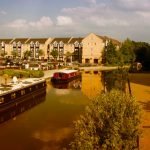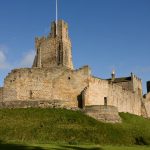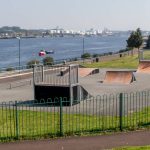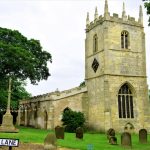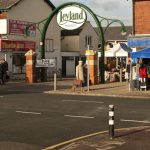Is it worth killing time in Killingworth? We bet nobody has ever made that joke before…
Killingworth is best known as one of the 1960’s rounds of New Towns. The New Town sprung up around what had been Killingworth Village since the early days. The village was all but consumed by the influx of new bodies. Killingworth was one of North Tyneside’s numerous mining towns. Later, the New Towns were unemployment traps with lots of people and few jobs. Let’s find out how Killingworth performed both before and after it was swarmed with city folk looking to escape.
The Early Days of Killingworth
Killingworth is somewhere between the sea and the city of Newcastle. Situated in Northumberland and in the north part of Tyneside, it has a long history as a coal mining town. Although the New Town didn’t spring up until the 1960s, the town had a long-standing history before then.
Killingworth and the moor it was built on both take their name from an Anglo-Saxon word. Cylla was actually the name of someone who presumably led the people here. Pronounced ‘Killa’, this would later become Cylla’s town or Killingworth. The town and space around it were the property of the Earls of Carlisle for generations, from about 1100 onwards. The Killingworth family were first named in 1166 on paper. They could be descendants of Cylla or they could have been a local noble family who took the town’s name. They stayed in the town until 1705 when the family line finally naturally died out.
In 1242 the land held by Roger de Merlay III underwent tax collection. By 1296 there were 9 taxpayers in town. 1373 census records 7 tenement buildings. The township had 1800 acres of common land on the moors to keep cattle and other animals.
The Medieval Era
The town remained a sleepy village for hundreds of years. Although several families descended from the female line, the Killingworth’s themselves died out. An Admiral lived in town for a while, in the area known as Old Killingworth. As with many northern towns, Killingworth did not appear in King William’s Domesday Survey of 1086. This is likely because his inspectors never made it this far north. At the time, there was less of England. Anything in Northumberland was in a separate kingdom. Although King William did erect several castles in the north to try and secure his grip on it, he never really took it over.
The history of Killingworth has a natural break during the middle ages. Let’s take advantage of that break to look at some fun facts.
Fun facts about Killingworth
In this section, we pause, take a deep breath, and uncover all the gossip we can find. Everyone likes a good tall tale. Here are the fun facts and trivia we found out about Killingworth:
- The town shares its name with Killingworth in Connecticut. We even managed to track down a picture of the Killingworth Cowboys, posted during the town’s 350th-anniversary celebration.
- Killingworth shares its name with Killingworth in Australia. The latter was named for the original after coal seams were found underground.
- The Lake is not natural. Killingworth Lake was part of the rewilding process to get rid of the old mine works. Sometimes when you have a big hole like that it is easier to flood it than it is to deal with it. The Lake contains carp, bream, roach, tench, perch, rudd and pike.
- Killingworth used to have an eyesore of a council estate in the middle of town. Built-in the 1970s, people were ashamed to say they lived in the unsightly block. Killingworth Towers saw demolition at the end of the 80s and, according to locals, not a moment too soon. The apartments were deemed unsuitable for human habitation by the time they were knocked down.
- The colliery here was famous internationally. Killingworth had a monstrous coal seam under it. Lord Ravensworth, a known name in coal, sunk the West Moor Pit. There was a second Killingsworth Colliery just to the south of town.
- A Dr Who episode showed the doctor going back in time to meet George Stephenson in Killingworth. FYI they didn’t film it here, which makes perfect sense. They filmed it in the Open Air Museum at Blists Hill in Ironbridge.
As you can see, the town’s fortunes were closely tied to coal and mining it back in the early days. Let’s find out what happened during the industrial era before we move on to the modern day.
The Industrial Era
Killingworth is a coal town, of course, as many other towns in the area were. The main colliery was Killingworth Colliery. The West Moor Pit opened in 1802 when the first deep shaft sunk. Miners completed the work in 1802 and the mine didn’t close doors until 1882. George Stephenson worked here as a miner, but upon fixing an engine became promoted to engineer. In 1813 he worked on his first steam locomotive. He invented a hand-powered lathe which is still on display at Newcastle University. He did all this from a workshop he built himself behind his house. Dial Cottage, on Lime Road.
His first locomotive was short-lived but hauled 30 tonnes of coal successfully around town. It led to further steam locomotives carrying coal up and down the country. In 1814, he invented a safety lamp that prevented explosions in the mines when dirty air contacted exposed flames. Prior to the invention of the swathe of safety lamps that came from the northern miners, the mines had frequent explosions. The canaries in cages are not as reliable as the stories say.
He tested and displayed his new lamp in front of Lord Humphry Davy, who presented his design to the Royal Society in London. The Geordie Lamp, as they called it, went on to grace mines all over England and saved countless lives as a result.
A Dangerous Occupation
How bad a problem were miners dying due to explosions? A quick Google search tells you all you need to know. A Felling Colliery explosion killed 92 men and boys, while a Wallsend explosion killed an estimated 200 in 1835. In 1839 St Hilda’s in South Shields blew up, while the Hartley Colliery disaster of 1862 killed 204 men. Jarrow colliery blew up in 1817, killing 6, then again in 1826, killing 42, and again in 1828, killing 8, then in 1830, killing 42… you get the idea. Nobody went into the mines because they wanted to. They went into the mines because it was that or starve. At least if you were lucky the explosion would kill you quickly.
From the 1700s, races were held in spacious moors. Later, these races would move into Newcastle where the attendance and publicity were better. The town could have done with the revenue the races brought in but, when you live in the shadow of a city, none of your ideas stays your own.
The 1841 census records there were 112 people living in Killingworth. There were only 14 recorded buildings, so that is more than ten to a house. This was normal behaviour for poor folk. The census recorded two rows of houses on either side of a single road. There were farms to the north, the new mines opening in the south and north, and few stone buildings. There were pits below their feet, so when the builders did come to erect the New Town a hundred years later, they had serious infilling to perform.
Modern Day Killingworth
In 1964, the local council made plans to rewild the old colliery pit. Killingworth Lake to the north of town and the industrial estate were both built on former pit land. The Lake is 15 acres long and built on the 760 acres of land to the outskirts of the village. It was on these 760 acres that the council built the New Town in 1963 after closing the pits.
The New Town was never part of the government’s official scheme. Rather, it was undertaken by Newcastle city council, who have a long history of being far enough from London that they have to do things themselves. They designated the 760 acres just outside of town to the cause and hired builders to get to work. Original plans for Killingworth intended to create homes for 20,000 people. The initial building work was excellent for its time.
With the exception of the Towers, the town won awards for a brutalist architecture approach which combined high-rise buildings with an avant-garde style. The houses were almost unanimously concrete and between 5 and 10 storeys high. The town centre featured a shopping mall and the surrounding areas incorporated industrial estates and retail buildings. There was enough room for car parks, ramps, and walkways.
Killingworth Township
The New Town was meant to be Killingworth Township to distinguish it from the village. It didn’t take. The larger town dropped the ‘township’ and became simply ‘Killy,’ which it has been ever since. Killingworth Village remains a small settlement to the southeast of the New Town. This area is still somewhat countrified.
Killingworth New Town was supposed to create a space where the old village and city life met over rolling hills in the countryside. Concrete, cast iron, and gratings conspired to create a cold, unfeeling effect in the housing estates. Many of those problems have since become rectified with the demolition of the tower, but Killingworth carries that stamp of New Town concrete to this day.
Boxer Henry Cooper opened the shopping centre in the 60s and much of the remaining buildings were destroyed in the 90s. The new town centre is far smarter, sleeker, and projects the image of a modern business town. The 80s and 90s were a sad time for Killingworth residents. The last two decades have seen much-needed growth to create a better town centre and a pleasant community with more work and better prospects all around.
Killingworth is an ex-mining town. It is a formerly industrial town refocusing on retail. It holds the welcoming spirit of the northern people who will embrace tourism and travel. That same spirit never gave in to the Normans and fought those Romans every step of the way. Then, when industry arrived, spent their time in holes in the ground. They’re tough but fair. That’s just about as northern as you can get.
Famous People from Killingworth
It wouldn’t be a proper travel guide if we didn’t point out all the people you could meet at the supermarket. Here are the top living and historic celebrities from Killingworth, so you can be aware of whose hand you might brush against reaching for the plums:
- Obviously, we have to mention George Stephenson again. He saved a lot of miners from the gassy underground of Tyne and Wear.
- The only other famous resident we could find from the area was Admiral Robert Roddam. He joined the navy in 1735 and worked under Horatio Nelson. He died at Killingworth House as Admiral in the Royal Navy. He married a Clinton from the USA and eloped with her, but she died only a year into the wedding. He married again, lost a second wife, and married a third time at 80 years old.
Though there are a surprisingly low number of famous people from this area, there are bound to be emerging stars we don’t know about. Add a comment below if you know of any others.
Best things to see and do in Killingworth
It’s that time you have all been waiting for – the big reveal of the best things to see and do in Killingworth. Hang onto your hats and get ready to explore.
Historic sites
Head north to Burradon Tower to get a good look at an overgrown and abandoned building. Burradon Tower is a Scheduled Ancient Monument and Grade II listed building. It was part of John Orde’s estate in 1441 when the Scots sacked it. The inferior quality of the soil also meant the tower only made about 20 shillings a year. The tower ruins as they are today are likely part of a 1553 restoration/renovation. It is worth the visit if you like cool abandoned places. It is mostly standing, but don’t go inside as it is dangerous.
Landmarks
Head to Ouseburn in the northeast of town to explore one of the area’s most unique and creative communities. This suburb near Killingworth was once the centre of an industrial revolution. Similarly rewilded, it has become Newcastle’s cultural quarter. There are allotments, funky flats, and plenty of plants. Take a wander through and enjoy coffee in the coolest places in town.
Go spend some time at the man-made Killingworth Lake to the south of town. It has a wonderful park attached to it, where you can take the kids and let them run free. There is a colony of mute swans in the lake and they occasionally have Bewick swans visiting. The area is popular among birdwatchers. There is a model boat and yacht club on the lake, as well as fishing jetties for the avid anglers among you.
Outdoor attractions
Head out to one of the famous parts of the countryside up north and see Northumberlandia. This carved sculpture is etched into the hillside itself. It’s a massive work of art and a scenic walk for any explorer. There are trails all over the park. The Land Trust runs the Lady of the North site. Take your big jacket and your camera and prepare for some awe-inspiring views.
Cultural Sites
The nearest museum to Killingworth is the Great North Museum. This charming museum operates exhibits from all over the world, including Egyptian sarcophagi and Iraqi historical artefacts. You can visit for free but they do ask that there be no entry 15 minutes before closing time. You can find out all the other details on their website.
Sports and teams
Killingworth is close enough to Newcastle Racecourse that you can spend your long weekends enjoying days at the races. Dawn your best hat and head into town for a splendid day of gambling fun. The racecourse is inside High Gosforth Park and is known as one of the UK’s busiest tracks. It offers space for exhibits, conferencing, and even private parties.
Most of the residents of Killingworth are understandably Newcastle United fans. The local team is the Killingworth Young Peoples Club. There is also a Killingworth FC who plays in the Northern Football Alliance League. They are a full-time team.
The nearest golf club is Parklands Golf Club, but you also have the option of using the Gosforth Golf Club, inside the park there. Both are about 6 miles from Newcastle Airport.
Recreation
Spend some recreation time out in High Gosforth Park to the west. This huge area of natural grassland even contains a golf course. However, enjoy walking around the waterways there or visit their winter wonderland if the timing is right.
The nearest cinema is the Vue in Cramlington, you will find all your shows there. You can even get to it by hopping on the nearest Metro. There is also an Odeon in Wallsend.
Shopping and Retail
Killingworth has a reasonable shopping centre in the middle of town. It was one of the first things that the architects built here. There are a few clothes and shoe shops, Places to buy gifts, there are betting stores, card shops, and even a carpet shop. If you can’t find what you are looking for in the Killingworth Shopping Centre, you can always hop on the nearest Metro and head into Newcastle town centre. It is only a few minutes away.
Where to eat and drink in Killingworth?
If you would like a pint and a pie, check out the Plough Inn in the W Farm Cottages. If you want a cocktail and maybe a dance then head to The Printworks, which is not a printworks at all but a bar. If you like your pints in the company of a newspaper and a sports event, try the Kings Arms. If you are a serious foody, the nearest fine dining restaurant is in Newcastle. Kenny Atkinson’s House of Tides is closest, with Raby Hunt near Darlington a runner-up.
Other Notable Nearby Attractions
If you stay in town for long enough to see all the local attractions, you might want to travel slightly farther afield. This area of Tyne and Wear has attractions everywhere, so here are the best picks of things to do in your area:
- Visit Houghton-le-Spring in October for the feast
- Take the kids to one of Hebburn’s pretty parks
- You have to go to the Wallsend museum and learn about the Romans
- Skelmersdale is a similar town to Killingworth, you might like it
- Nearby Cramlington had wall-to-wall coal mines under it
- Go to a market day in Hexham for a drive
Otherwise, welcome to the north. Please enjoy your stay and remember to take your rubbish home with you. Keep your hands and feet inside the vehicle at all times. Strangers may be friendly enough to lure you into drinking competitions and ply you with scones. Be on your guard.
How to get to Killingworth?
Travel guides are supposed to give you directions so here are some of the best…
By Road
Head northeast out of Newcastle on the A19 to get to Killingworth, both the town and the village.
By Air
Look for Newcastle International Airport.
By Rail
Killingworth station is disused since the coal boom ended. Get the Metro to Palmersville or Benton, instead.
By Sea
The nearest port to Killingworth is the Port of Tyne.
Got Five Minutes?
If you enjoyed this article and you want more like it, there are three things you can do to help out. You could follow us on Facebook to hear the latest updates, you could create a member account with Five Minutes Spare, or you can browse similar articles on our site. Remember, sharing is caring when it

